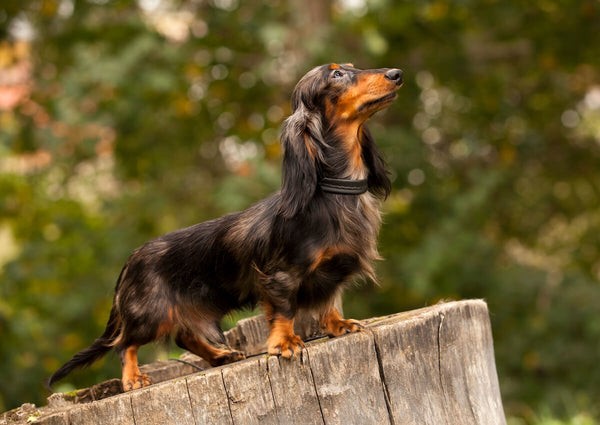
Despite their charming personalities and luxurious coats, long-haired dachshunds are not hypoallergenic dogs. These beloved sausage dogs shed moderately throughout the year and produce dander, saliva proteins, and other allergens that can trigger reactions in sensitive individuals. While their shedding may be less noticeable compared to some larger breeds, their fur still contains allergenic proteins that can affect those with pet allergies. This report examines the allergenicity of long-haired dachshunds, shedding patterns, grooming requirements, and management strategies for potential owners with allergies.
Long-Haired Dachshund Allergenicity
Allergen Production and Shedding
Long-haired dachshunds are not hypoallergenic and produce allergens through their dander, saliva, and urine that can trigger allergic reactions. While their longer coat requires more maintenance, the shedding amount is comparable to smooth-coated varieties. They shed moderately year-round rather than seasonally.
Grooming Requirements for Allergy Management
Long-haired dachshunds need daily brushing with a metal comb, slicker brush, or pin brush to prevent matting and minimize allergen spread. Their coats can develop tangles that pull painfully at the skin if not properly maintained. Regular grooming helps remove loose fur and dander but will not eliminate allergens completely. People with dog allergies should spend time with long-haired dachshunds before adoption to assess their individual sensitivity levels.
Understanding Long-haired Dachshund Shedding Characteristics and Patterns
Seasonal Shedding Variations
While previous sections covered general shedding amounts, long-haired dachshunds experience minor seasonal variations in their shedding patterns. Though they shed moderately year-round, they may experience slightly heavier shedding during spring and fall coat transitions. However, these seasonal changes are less pronounced compared to double-coated breeds.
Coat Texture Impact
The wavy texture of long-haired dachshund coats affects how shed hair is trapped and distributed. Their sleek, slightly wavy fur tends to hold onto loose hair rather than immediately releasing it into the environment. This means shed hair often remains caught in the coat until brushing, rather than freely floating around the home. Regular brushing helps remove this trapped loose fur before it can accumulate and mat.
Managing Shedding in Long-haired Dachshunds: Effective Grooming and Care Tips
Nutrition and Supplements for Coat Health
While previous sections covered grooming techniques, proper nutrition plays a vital role in managing shedding. A balanced diet supplemented with omega-3 fatty acids helps promote healthy skin and hair follicles. Adding supplements specifically designed for coat health can reduce excessive shedding by strengthening the hair shaft and supporting natural oil production.
Protective Clothing Solutions
Beyond standard grooming, specialized clothing for dachshunds can help contain loose fur. Light shirts and protective wear designed specifically for long-haired dachshunds can trap shed hair before it spreads throughout the home. This approach is particularly effective during peak shedding periods and helps minimize the time spent cleaning up loose fur while protecting the coat from matting.
Long-haired Dachshund Health Impact on Allergies
Medical Considerations
While previous sections covered general allergenicity, research shows that individual dachshund health conditions can affect allergen production levels. Skin conditions, hormonal imbalances, and stress can increase dander production and worsen allergy symptoms. Regular veterinary checkups help identify and treat underlying issues that may elevate allergen levels. Monitoring for excessive shedding or skin problems allows early intervention before allergic reactions intensify.
Trial Period Assessment
Before committing to a long-haired dachshund, allergy sufferers should conduct a trial period through fostering or pet sitting. This controlled exposure helps evaluate individual tolerance levels and reaction severity. Testing interactions in different environments and during various activities provides insight into potential trigger situations. The trial period should last several weeks to account for varying allergen sensitivity patterns.
Conclusion
Long-haired dachshunds are not hypoallergenic dogs, as they produce allergens through dander, saliva, and urine while shedding moderately throughout the year. Their wavy coats require daily brushing and proper grooming maintenance to manage loose fur and dander, though this will not eliminate allergens completely. While their coat texture tends to trap shed hair rather than release it freely, they still contribute to indoor allergen levels through regular shedding patterns that increase slightly during seasonal transitions.
For allergy sufferers considering a long-haired dachshund, proper management through consistent grooming, nutrition optimization, and preventive health care is essential but may not be sufficient to prevent reactions. The research strongly recommends conducting an extended trial period through fostering or pet sitting before adoption to assess individual sensitivity levels and determine if coexistence is feasible. This careful evaluation, combined with ongoing allergen management strategies, will help potential owners make an informed decision about bringing a long-haired dachshund into their home.